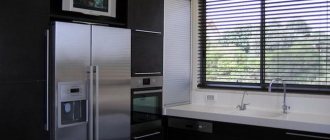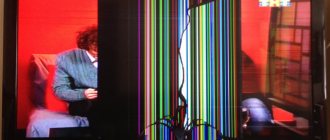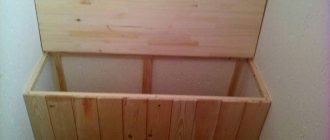What to consider when determining height
The main task of a TV on the wall is to view it, that is, the height should be suitable for all viewers. Therefore, first of all, evaluate - from what position do you plan to watch the programs? If this is a sofa, then you need to take into account the standard position of a person - sitting or reclining. Place the TV screen at eye level.
What are the dangers of improperly installing the TV:
- Higher than necessary. The head is constantly thrown back, the neck muscles are tense. Headaches and cramps occur.
- Lower than necessary. Head down. Pain in the cervical spine and headaches may occur.
- Closer than necessary. Sitting too close means increasing the strain on the eyes several tens of times, which will lead to deterioration of vision.
- Further than necessary. You will have to constantly strain your eyesight, it will be uncomfortable, you won’t be able to see the details.
At what distance should you hang the TV?
The most optimal distance from the viewer to the TV in terms of comfort and safety is 3-4 screen diagonals. That is, if the TV screen is 20 inches, then you need to watch it from a distance of approximately 60-80 inches (1.5-2 meters). This rule must be observed especially when it comes to a plasma TV.
LCD TVs can be viewed from a distance of 2 diagonals, but it is still advisable to maintain a distance of 3-4 diagonals.
When watching TV, it is best to sit so as not to move from the center point of the screen by more than 15-20 degrees, maximum 30 degrees.
Basic rules for placing a TV:
- position the display so that the center line is opposite your eyes;
- install a bracket with adjustable position if you want to watch broadcasts from different places;
- do not place the TV on the wall above appliances that emit heat (fireplace, radiator, hob);
- take into account the height of the household, the height of the furniture seats, when calculating the distance from the floor - the average value is 80-120 cm.
Optimal placement of the TV from the floor
When we watch TV, we must consider the following:
- The posture in this case is usually relaxed, sometimes reclining. However, it is inconvenient to tilt your head or, conversely, keep it constantly bent or inverted - the neck is affected. This means that the screen should be approximately at eye level of a person sitting in a normal sitting position;
- The distance to the center of the panel should be approximately twice the diagonal of the screen. For example: You have a 55-inch TV, convert it to centimeters (i.e. multiply this number by 2.5, see more details here) - 140 cm. Multiply by two and you will get about three meters from the eyes of a sitting person to center of the screen. In some cases, it is impossible to maintain this distance horizontally, then you can place the equipment higher and get the desired distance - but you will have to watch movies and TV shows lying down. This is a good option for the bedroom.
Sometimes the problem of the height of the TV from the floor is solved by the rule “where it fits, we hang it there.” This happens if the furniture has a recess for the LCD panel, or if shelves and bookcases are already installed and we do not want to change them. In this case, it is worth checking whether watching TV will be comfortable: just sit in the planned place and watch more or less in the center of the empty space. Is it comfortable, your neck doesn’t hurt and you don’t have to turn your head? Perfect! Uncomfortable? Then you need to change something - either the sofa (bed, chair, etc.) or the technological place.
So the eye level of the person sitting should be approximately the center of the screen. Another option is to have a point at this level offset about a third from the bottom edge of the panel.
This option will be more convenient if a person periodically changes his position, sitting higher or lower. But there is one more nuance here - it is desirable to be able to change the tilt of the screen.
Let's try to summarize - at what height to hang the TV on the wall:
- At eye level of a seated person there should be either the center point of the screen or one third of the height from the bottom of the panel;
- The distance from the floor to this point should be 1...1.3 m. For people up to 160 cm tall, we recommend 1.1...1.15 m, for people 1.2...1.3 m tall. Consider the height of the sofa!
- If the gaze comes from different points in the room, from different positions - sitting, standing, lying down - we choose the arithmetic mean, that is, still at the level of a sitting person;
- Consider the possibility of rotating/tilting the screen.
For TVs of different sizes, recommendations can be summarized in a table.
| Diagonal in inches | Height, cm | Distance from bottom of screen to center, cm. | Distance from the floor to the center of the screen (eye level of a sitting person), cm. | The height of the TV from the living room floor (height from the floor), cm. | Height of the TV on the wall (at the top edge of the panel), cm. |
| 19 | 42 | 21 | 100…120 | 79…99 | 121…141 |
| 21 | 46,5 | 23 | 77…97 | 123…143 | |
| 22 | 49 | 25 | 75…95 | 125…145 | |
| 24 | 53 | 26,5 | 74…94 | 126,5…146 | |
| 28 | 62 | 31 | 69…89 | 131…151 | |
| 32 | 71 | 35,5 | 65…85 | 135,5…156 | |
| 40 | 86 | 43 | 57…77 | 143…163 | |
| 43 | 95 | 47,5 | 53…73 | 147,5…168 | |
| 49 | 108 | 54 | 46…66 | 154…174 | |
| 50 | 111 | 55,5 | 44…64 | 155,5…176 | |
| 55 | 122 | 61 | 39…59 | 161…181 | |
| 58 | 128 | 64 | 36…56 | 164…184 |
A closer look reveals that if these standards were adhered to, large diagonal TVs would have to be suspended almost above the floor, which is risky in terms of the integrity of the equipment. In this way, adjustment can be made. If the minimum resulting distance is less than one and a half meters, then it should be increased to this value.
Important: If the TV is used not only for viewing, but also to control consoles ( Xbox, Playstation, Nintendo) and special devices (active games with motion capture, “augmented reality”) must adjust the height.
In this case, the position of the median should be considered as the average between its position for a sitting and standing person. Example: Children with a height of 120 cm and adults with an average height of 170 cm watch TV in normal mode, a child with a height of 140 cm plays “fight without rules” with an “augmented reality” device. Therefore, the center of the screen should be at a height of about 125 cm.
First method
First, determine the height at which the bracket system components will be mounted. Sit comfortably at your vantage point. Close your eyes for a few moments. Now open them and look at the wall in front of you. The area you are looking at is the center of the TV screen. This is where the main bracket is attached.
If you prefer this option, then you need to understand that indicators such as the distance from the viewing area to the TV device and the diagonal of the monitor are completely ignored. With a high degree of probability, we can say that your eyes get tired while watching. Despite the simplicity of this method, it is wise to choose the second option.
Second way
This approach requires mathematical calculations. The doctors' recommendations were taken into account. First, the screen should be at eye height. If it is higher or lower, the image is distorted. Secondly, the optimal viewing distance for an LCD TV is the diagonal multiplied by 3. If it is a plasma, then the display size is multiplied by 4.
When installing LED or 3D TVs, it is important to consider not only the diagonal, but also the screen resolution. 720p or 1080p? These parameters affect the image quality, and therefore the viewing comfort. The installation height of such devices should be calculated according to the following rule:
- For 720p devices, the installation height will be equal to the diagonal multiplied by 2.3.
- For 1080p models, the installation height is calculated by multiplying the diagonal by a factor of 1.6.
When determining height, consider the distance from the viewing point to the screen, as well as from the user's eyes to the device.
Calculation of the correct position
It is for the sake of comfortable relaxation and watching TV shows that a TV is actually purchased, but for each room the height of its placement will be different. Why and at what height is it better to hang a TV receiver?
Watching programs in the kitchen soon turns into listening, so the height of the screen is not very critical, and in the kitchen the TV panel is hung higher than the calculated height, so that it does not interfere with work. Such fastening does not cause discomfort when watching programs.
To decide at what height to hang the TV in the living room, they start from maximum comfort when watching.
Medical studies have proven that the most optimal way is to mount the TV so that the distance from the bottom edge of the screen to the floor is 0.75-1 m.
Doctors also give practical advice on how to intuitively calculate the distance from the viewer to the TV screen. To do this, sit in the place from which you plan to watch TV, close your eyes, and after a minute open them. Where your gaze immediately fell, that place should be the middle of the screen.
At what height should you hang the TV on the wall in the bedroom? The recommended installation height of the panel will be slightly higher than in the hall or living room, and you can determine the placement point of the device in the same way as with the previous solution, i.e. just lying on the bed. The main rule when calculating the installation height of a television panel is your comfort when viewing.
In modern TV models, the picture does not flicker, and the screen does not emit electromagnetic waves, that is, it does not pose a danger to the eyes.
Therefore, you can watch a liquid crystal or plasma panel at any convenient distance, and installing a TV on the wall is possible in any case.
But the optimal ratio between the TV diagonal (the diagonal is the length between the upper and lower corners of the screen) and the distance from it to the viewers’ eyes still exists.
Placement in the bedroom
Placing a TV in the bedroom depends on many important reasons. One of the main things is what kind of bed you have. If you close your eyes while lying on your low bed and relax for a while, then you can take the most comfortable position for you when watching programs.
By opening your eyes and mentally marking the place on the wall where your gaze falls, you will receive an answer at what height is best to hang the TV in the bedroom.
Most likely, it will be slightly higher than where the TV is installed in the living room, but you should remember the advice of doctors - do not exceed the angle of deviation from the center of the screen when viewing, which Ideally it should be no more than 30 degrees.
Otherwise, osteochondrosis of the cervical spine, which occurs due to incorrect head position and prolonged viewing of television, will soon make itself known.
To more accurately adjust the deflection angle, care should be taken to use high-quality mounts for brackets with a variable inclination angle for installing the TV on the wall. monitor plane.
It is advisable to use brackets that adjust the monitor position in two planes, not only in tilt, but also in rotating the screen left and right.
Before installing a TV in the bedroom, you need to find the place from which it is most likely to be viewed. For a lying position, you should choose a higher height: slightly higher than the usual direct gaze in a standing state.
The ideal option is still considered if the tilt angle during viewing changes no more than 30 degrees from the center of the screen.
As a way out, you can use a wall bracket. In this case, you can change the rotation of the TV at any time.
The bracket is attached as follows:
- The middle of the bracket is fixed at a level of 150 cm from the floor.
- Outlets for sockets and cables are mounted 25 cm above the bracket.
At what height should a TV hang in the kitchen?
The standard use of the receiver in the kitchen is as a background for cooking or during a lunch break. One way or another, people look at the screen itself in fits and starts, so hang the TV on the wall almost any way you like.
In the dining area, the preferred location is above the table, at a level of 1.2-1.5 meters from the floor. In the work area - above the refrigerator or in any free area.
Consider unsuitable proximity:
- It is considered unacceptable to place near heating devices (cooking, oven), wet areas (sink);
- Because of the sun's glare, it is equally uncomfortable to watch a TV located on a wall with a window opening or opposite it.
When calculating at what distance from the floor to hang the TV in the kitchen, analyze your habits. If you watch it more often while cooking, calculate the level based on your standing height. Are you used to learning the latest news over a cup of coffee? Set at eye level while sitting. A tilt-and-swivel bracket would be useful for the kitchen - then you can use the TV while standing at the stove or sitting on a chair at the dining table. The panel is installed at the highest suitable point, and in order to look from below, it is simply tilted. The main thing is to position it in such a way as to prevent injury when the panel is tilted.
Installing a panel in a bedroom or nursery
The height of the LCD panel in the bedroom depends on the arrangement and parameters of the furniture; the ideal option is to place the TV on the wall, perpendicular to the bed. This makes it convenient to watch movies while lying down or half-sitting. But parallel installation is also allowed.
The center of the screen should be in front of your eyes when viewing while sitting, but please note that the screen must be tilted approximately 30°. A distinctive feature of LCD monitors is that when viewed at an angle, contrast is lost and the image darkens, which has a negative effect on vision. The tilt of the panel will provide a direct view from a “lying” or “half-sitting” position.
It is important to know! For maximum comfort, choose adjustable brackets. With their help, you can change the tilt of the panel or rotate the TV left or right. If you decide to rearrange it a little, or like to watch movies in different positions, the direction of the screen can be easily adjusted.
LCD panels with a TFT matrix have a fairly wide viewing angle, but are sensitive to vertical deviation: a low position increases the contrast and darkens the screen, while a too high position, on the contrary, brightens it.
As for the children's room, when calculating at what height to hang the TV, rely on the child's height. The panel should hang in such a way that children do not touch it with their heads or hands while playing; this can injure the children and also damage an expensive item.
The active lifestyle of the younger generation involves watching TV from different points: from the floor, from the bed, from behind the desk or even standing. Therefore, it is difficult to calculate the optimal position; the individual furnishings of the room play a big role here. It is important to take into account the angle of inclination so that the contrast and darkening of the picture does not harm children's eyes and does not create stress on the spine, which is not yet strong at a young age.
Determining the height in the children's room
Whether a child even needs his own TV in an apartment, whether it is harmful or useful, is a controversial issue. Children who are too active while playing ball can injure themselves or drop the LCD. If you are determined to install an LCD, first of all, correctly determine at what height on the wall to hang the TV.
- Firstly, like everything for children, height should be determined based on growth. This is especially true during the active growth phase, otherwise the panel will have to be re-hanged every year.
- Secondly, answer yourself the question: for what purpose is the TV installed. Playing a console is one thing, watching before bed is another.
Rules for placing the TV in the nursery:
- the position of the lower part should be higher than the child’s height to prevent impacts during games;
- Preferably the use of static brackets that do not allow the child to move or tilt the TV in order to avoid damage.
Children usually watch TV while playing or doing other activities, so it is difficult to determine the main position. Hang the bracket opposite one of the main sitting places (bed, sofa) - and the baby will figure out other options on his own.
In the case of determining a place for a TV, the saying “Measure seven times, cut once” is especially relevant. To avoid damaging the wall with extra holes, check your calculations and only then begin installation.
Content:
- 1 Why height matters so much 1.1 Advantages and disadvantages of fixing to the wall
- 5.1 Installation in the living room
Television is a companion for home relaxation. Buying new home appliances is a wonderful event. And now, the TV has been delivered and unpacked. But the question arose, at what height to hang the TV in order to get maximum pleasure from watching a movie. After all, the quality of picture perception is affected by the viewing angle, distance and mounting height. Let’s take a closer look at the last point – the height and method of mounting the display.
Is it possible to hang a TV on the wall above the fireplace?
Manufacturers of LCD and plasma TVs do not recommend placing TV panels near any heating devices, or in places where the sun's rays fall most of the day. Therefore, you should not place a TV panel above a constantly functioning fireplace.
Although, if you really want, you can conduct a small experiment - measure the temperature of the wall above a cold fireplace, then heat it up and after a while measure the wall temperature again. If it does not increase or increases slightly, the TV can be hung.
What influences the choice of TV location
The model of the equipment itself affects the choice of installation height. Rounded panels are difficult to fix to the wall - the rounded corners will protrude greatly. But flat-screen TVs are easy to fix anywhere.
The choice of movie viewing range and fixation height is influenced by the screen diagonal and the size of the equipment. The correct values can be calculated using the formula L = kD, where the letters represent the following:
- L – distance from the display;
- D – TV diagonal;
- K is the resolution coefficient, for example, for HD it is 2.3, for Full HD – 1.56, and for UHD – 0.7.
Let's understand the formula using an example. Purchased a TV with FullHD resolution and a diagonal of 32 inches. We apply the formula: 32 * 2.54. We get the location range - 81.28 cm.
The height of the TV from the floor is calculated along a conventional straight line from the eye level of the viewer. At the same time, it is important to sit in a comfortable position on exactly the furniture with which you will be watching TV. As a result, the dimensions turn out to be conditional. And the distance to the TV is the minimum indicator for good picture perception.
Interesting fact. Doctors advise placing equipment at a distance of 175 cm, with a height of 75 cm from the floor to the bottom edge of the display.
Types of mounting brackets
Before hanging your TV on the wall, you should consider all types of fasteners recommended by the manufacturer.
In most cases, you can purchase three types of brackets for each model:
- hard;
- inclined;
- universal (turns sideways or up/down).
The latter are the most convenient and expensive. The first two types are purchased if you are absolutely sure that there will be no rearrangements of furniture in the near future, and the planned position of the TV will be comfortable.
A rigid mount implies a small gap for the ventilation holes of the device - about a few centimeters. The TV receiver will be installed permanently, without the ability to adjust the viewing angle.
How to calculate the correct position of the TV from the floor level?
Calculating the correct position of the TV from the floor level
As we already know, the optimal location of the panel is very important, both for comfortable viewing, but also for the health of household members. However, not everyone knows how to calculate the correct position of the TV from the floor level. We'll talk about this further.
- The best height for the TV in relation to the floor is about 1 meter .
- However, there is a guideline to follow: the middle of the screen is in front of the viewer's eyes .
- This means that you need to take into account the height of the furniture - the higher the seat, the higher the position of the TV should be.
TV mounting height from the floor
To calculate the correct height of the panel position relative to a certain room interior, you need to do the following:
- Sit on the sofa as comfortably as possible.
- Relax and close your eyes.
- Open your eyes and look at the wall where the TV is planned to be placed. The point at which your gaze falls should coincide with the upper third of the TV. Actually the middle should be a little lower.
It remains to add that when choosing the height of the panel placement, you need to take into account the quantity and type of furniture. For example, if there is more furniture in the room for spending time in a reclining position, then the height of the panel should be suitable for viewing in such an arrangement.
Features of mounting a TV on the wall
Points from the mounting instructions:
- Installing a TV panel weighing more than 25 kg requires the effort of two people.
- Preference should be given to a specialist in the installation of plasma, LCD and LCD TVs. If you are confident in your abilities, then you can try to install it yourself.
- The weight of the TV must be such that the wall can support it. Overly heavy monitors should not be hung on the wall; it would be better to consider another option.
- Connection to cable and satellite networks is completed after installation.
- Manufacturers advise hanging the TV panel in a place with good air circulation to ensure the necessary ventilation through special openings in the housing.
- When mounting it on a sliding bracket, you need to keep in mind that the wiring connected to electricity is not stretched, otherwise a short circuit or fire may occur.
Installing a TV on the wall, among other things, saves space, since there is no need for bulky TV cabinets and stands.
In rooms in the minimalist style, mounting TVs on the wall is carried out for the same purpose - to remove excess furniture, but not for the sake of saving square centimeters, but to create that atmosphere of lightness, which is the main highlight of the minimalist style.
Thus, plasma and LCD TVs lighten the space, but they themselves are not at all light, especially if we are talking about a large diagonal TV. This means that hanging a flat-screen TV on the wall is much more difficult than the same picture or mirror.
Installation of mounting frames
We come to the most interesting section - the technical support for the entire event of placing the TV on the wall.
First of all, let’s make a reservation that the instructions that will be described below apply to the concrete walls of a permanent house, but we’ll also say a few words about wooden and plasterboard walls.
We need the following tools and equipment:
- Hammer.
- Drills for concrete, thickness 7-8 mm.
- Caps, screws.
- Bubble level.
- Drawing tools - ruler, square, pencil.
Marking
Important! As a rule, all consumables, except for the hammer drill, of course, are included with the mounting frame.
On the wall we select an area for installation; we will talk about specific height parameters in the next block. Using a square, we draw a right angle while maintaining straightness, which is checked with a bubble level.
It is necessary to “fit” one of the sides of the mounting frame into this drawn right angle, so that the frame itself will be installed without distortions. Otherwise, the TV will be tilted to one side.
Important! If the holes are drilled skewed, then it is unlikely that you will be able to install the TV level without drilling additional holes. In turn, the structure of the concrete will not allow drilling two holes at a close distance - a mowing area or hole may form.
The frame is “marked” with a pencil along special holes. Markings on the wall are additionally indicated by a level for straightness.
Drilling
You could write a whole treatise on drilling concrete, but we will briefly outline the main points.
To prevent the drill from starting to wander when drilling the surface, it is necessary to stick small pieces of cloth medical plaster on the area under the holes. It has a roughness that will prevent the drill from “running up” when rotating until it goes deep.
Please note: You only need to work with a hammer drill and concrete drills.
The following points must be taken into account, which can lead to serious problems:
- It is necessary to find out the passage of electrical cable lines so as not to drill them.
- If the drill hits the reinforcement, you should not continue drilling into concrete. It needs to be replaced with a cutter for working with metal.
The entire procedure is carried out at a confident pace without deviation of the drill along the angle. After the holes are made, the choppers are hammered into them.
Walls made of wood panels and plasterboard
Wooden oriented panels or MDF have sufficient load-bearing capacity, so fastening will not be difficult. The holes are drilled with a drill without the effect of a hammer drill. Next, everything is carried out similarly to the measures for concrete walls.
As for drywall, it can only accommodate small, lightweight television devices. The material is lightweight and not intended for heavy loads. The weight of TVs ranges from 5 to 20 kg. average.
Installation
It is produced by simply aligning the holes in the frame with the holes in the wall. Self-tapping screws are screwed into the holes.
This is important: But there is also one important nuance: touching the mounting frame and the concrete wall without maintaining a gap of 15-20 mm. undesirable. Since this will not allow you to use the cable panel on the back cover of the TV - the wall will prevent the connection of plugs and the power cable.
To maintain the gap between the frame and the wall, cylindrical bosses are provided.
Important! Therefore, it is necessary to take into account the length of the screws - at least 100 mm. Otherwise, the fastening will be unreliable.
Basic rules from manufacturers
Wall mounting of a TV weighing more than 25 kg is strongly recommended to be carried out by two people.
TV manufacturers constantly remind in their operating instructions that only a qualified technician should hang a TV (this applies to both plasma and LCD), since illiterate wall mounting of a TV can be dangerous.
But if you have the skills to work with a drill and have golden hands, you should not be afraid of self-installation, unless, of course, we are talking about a very heavy TV:
- Before hanging a flat-screen TV on the wall, you need to make sure that it can support its weight.
- Cable connections are made after the panel has already been hung on the wall.
- Do not install the TV in a confined space - air must circulate freely through the TV's ventilation openings.
- When hanging the TV on a movable bracket, you need to make sure that when you turn it, the power cord will not be stretched, otherwise sparking and fire may occur.
These are the main recommendations of TV manufacturers. They must be followed first. Well, now let's talk in more detail about wall mounting.
We hang the panel ourselves
If you decide to hang the TV on the wall yourself, prepare a drill or hammer drill. It is necessary to make a mark how far from the floor to hang the TV. A concrete or brick wall is very durable. It can support a weight of more than 30 kg. For drywall, this indicator is the limit. The package includes a set of hardware required for attaching the wall part of the bracket. It is enough to make a hole in the wall and secure the profile.
In masonry and concrete, a hammer drill and concrete drill are used to create a hole. In drywall or wood - a wood drill.
Then the 2nd part of the bracket is fixed to the panel, and the TV is mounted to the wall. After this, the installation is considered complete, you can start watching TV.











